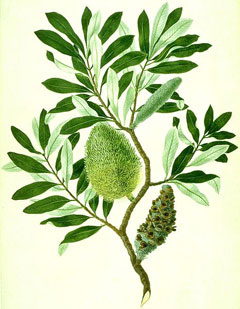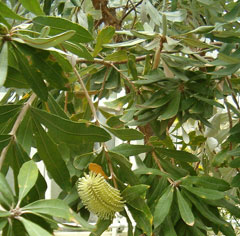 |
|
http://commons.wikimedia.org/wiki/File:Banksia_integrifolia_watercolour_from_Banks'_Florilegium_(cropped).jpg |
 |
| http://commons.wikimedia.org/wiki/User:BotBln |
Translate this page:
Summary
Physical Characteristics

 Banksia integrifolia is an evergreen Tree growing to 9 m (29ft 6in).
Banksia integrifolia is an evergreen Tree growing to 9 m (29ft 6in).
See above for USDA hardiness. It is hardy to UK zone 9 and is frost tender. It is in leaf all year, in flower from August to December. The species is hermaphrodite (has both male and female organs).
It is noted for attracting wildlife.
Suitable for: light (sandy) and medium (loamy) soils, prefers well-drained soil and can grow in nutritionally poor soil. Suitable pH: mildly acid and neutral soils and can grow in very acid soils.
It cannot grow in the shade. It prefers moist soil. The plant can tolerate maritime exposure.
UK Hardiness Map
US Hardiness Map
Synonyms
B. spicata.
Plant Habitats
Woodland Garden Sunny Edge; Dappled Shade; South Wall. By. West Wall. By.
Edible Uses
Edible Parts: Nectar
Edible Uses:
The flowers are rich in nectar and this is sometimes harvested as a food. It is best harvested in the morning before birds and evaporation deplete the yields[193]. The flowers can be sucked or soaked in water in order to obtain the nectar[193].
References More on Edible Uses
Medicinal Uses
Plants For A Future can not take any responsibility for any adverse effects from the use of plants. Always seek advice from a professional before using a plant medicinally.
None known
References More on Medicinal Uses
The Bookshop: Edible Plant Books
Our Latest books on Perennial Plants For Food Forests and Permaculture Gardens in paperback or digital formats.

Edible Tropical Plants
Food Forest Plants for Hotter Conditions: 250+ Plants For Tropical Food Forests & Permaculture Gardens.
More

Edible Temperate Plants
Plants for Your Food Forest: 500 Plants for Temperate Food Forests & Permaculture Gardens.
More

More Books
PFAF have eight books available in paperback and digital formats. Browse the shop for more information.
Shop Now
Other Uses
Rootstock Tannin Wood
The bark contains about 10% tannin[46, 154]. Used as a rootstock for other members of this genus[200]. Wood - soft, easily worked, pinkish with a prominent grain. It is highly decorative but the plants tend to be gnarled and irregular thus limiting its use. Used for veneers, furniture etc[154, 167].
Special Uses
Attracts Wildlife
References More on Other Uses
Cultivation details
Succeeds in most soils[157]. Requires a lime-free soil[1]. Thrives in acid sandy loams[167]. Prefers a pH between 6.3 and 6.5[200]. If this species is to be successfully cultivated, the soil should be low in nutrients, especially in nitrates and phosphates[200]. Quite resistant to wind and salt spray, it grows well by the coast[166, 200]. Plants growing in exposed positions have entire leaves whilst those in sheltered positions have serrated leaves[154]. Plants require greenhouse protection in most parts of Britain[1] but they succeed outdoors on a sheltered wall in the mildest areas of the country[166]. Plants in Australian gardens tolerate temperatures down to at least -7°c[157], but this cannot be translated directly to British gardens due to our cooler summers and longer colder and wetter winters. A polymorphic species, there are many named varieties selected for their ornamental value[200]. A good bee plant[154, 167].
References Carbon Farming Information and Carbon Sequestration Information
Temperature Converter
Type a value in the Celsius field to convert the value to Fahrenheit:
Fahrenheit:
The PFAF Bookshop
Plants For A Future have a number of books available in paperback and digital form. Book titles include Edible Plants, Edible Perennials, Edible Trees,Edible Shrubs, Woodland Gardening, and Temperate Food Forest Plants. Our new book is Food Forest Plants For Hotter Conditions (Tropical and Sub-Tropical).
Shop Now
Plant Propagation
Seed - surface sow in an ericaceous compost as soon as the seed is ripe or as soon as it is obtained and do not exclude light. Seal the pot in a plastic bag until germination takes place, which can take 1 - 3 months or more at 20°c[134]. When they are large enough to handle, prick the seedlings out into individual pots and grow them on in the greenhouse for at least their first winter. Plant them out into their permanent positions in late spring or early summer, after the last expected frosts. Cuttings of half-ripe wood, July/August in sand in a frame[200].
Other Names
If available other names are mentioned here
Native Range
AUSTRALASIA: Australia (New South Wales (east), Queensland (southeast), Victoria (southeast))
Weed Potential
Right plant wrong place. We are currently updating this section.
Please note that a plant may be invasive in one area but may not in your area so it's worth checking.
Conservation Status
IUCN Red List of Threatened Plants Status :

Growth: S = slow M = medium F = fast. Soil: L = light (sandy) M = medium H = heavy (clay). pH: A = acid N = neutral B = basic (alkaline). Shade: F = full shade S = semi-shade N = no shade. Moisture: D = dry M = Moist We = wet Wa = water.
Now available:
Food Forest Plants for Mediterranean Conditions
350+ Perennial Plants For Mediterranean and Drier Food Forests and Permaculture Gardens.
[Paperback and eBook]
This is the third in Plants For A Future's series of plant guides for food forests tailored to
specific climate zones. Following volumes on temperate and tropical ecosystems, this book focuses
on species suited to Mediterranean conditions—regions with hot, dry summers and cool, wet winters,
often facing the added challenge of climate change.
Read More
Expert comment
Author
L.f.
Botanical References
154200
Links / References
For a list of references used on this page please go here
Readers comment